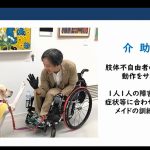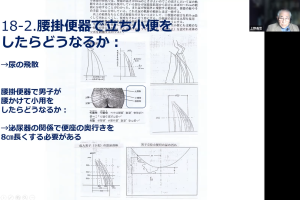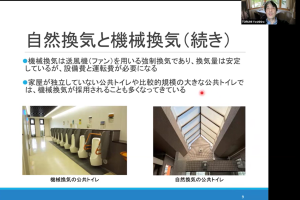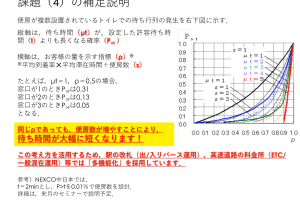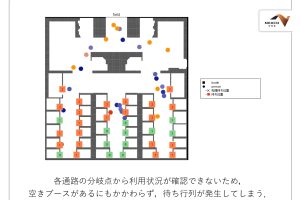Date: 18 August 2022 (Thu) 18:00-20:00 JST
Presenter:
Ms. Tomoko Hashizume, Managing Director and Secretary General of Japanese Service Dog Resource Center (JSDRC).
Organizer:
Yoshihiko Kawauchi, Ph.D., Japan Toilet Association steering committee member, Former professor of Toyo University.
(Hashizume)
It has been 20 years since the Act on Assistance Dogs for Persons with Physically Disabilities was enacted. I myself have been involved in the Assistance Dog activities for 20 years.
When the Paralympics were held in Tokyo in 2021, I was interviewed by The Washington Post asked me if the image of people with disabilities changed through the Paralympics, and Japan built a legacy in terms of how it can support the rights of people with disabilities? I was quite impressed by these questions. I have been interviewed by various Japanese media, but they have often treated Assistance Dogs as miraculous stories as the clever dogs. I think that this is quite the difference between overseas and Japanese approach. Only four Assistance Dogs visited Japan from overseas for the Tokyo Paralympics 2021: three Assistance Dogs from Israel and one from Canada. I hope these dogs spent good times in Japan and returned home.
【About Assistance Dogs】
There are currently 969 Assistance Dogs working in Japan. Among them, 848 Guide Dogs for the people with visual disability are the majority. The introduction of Guide Dogs has a history of 70 years. There are 58 Service Dogs for the people with physical disabilities. There are 63 Hearing Dogs for the people with hearing disabilities. The Service Dogs and Hearing Dogs were first recognized 20 years ago when the Act on Assistance Dogs was enacted.
When Guide Dog assists a person with visual disability, there are only three missions to inform to the user; the corner points, steps, and obstacles. A Guide Dog wears a harness, and the user get information about their surroundings through the tactile of the harness. When the dog stops at the left-turn corner, the dog body bends slightly to the left, and then people with visual disability can recognize it as a left-turn corner. In the case of a step, the user can recognize that the dog stops with the front foot on the step at the upward steps. The dog stops in front of the descending step before getting off and starts descending after the user recognizes it. The dog will avoid it and walk when there is an obstacle. Those are all missions of Guide Dog and there is no navigation duty to lead the user.
The people with visual disability will give directions to the dog by means of drawing a mental map in their brain with combining with information received from the Guide Dog. The places where the user already has a map in the brain, the user can walk rather safety using Guide Dog or a white cane. The user will be necessary the support by the people around, when the user is not familiar with the place to mobile or visits for the first time even with Guide Dog,
The dogs cannot recognize the traffic light colours. The user will sense the flow of cars and the movement of people surrounding and orders to Guide Dog to cross the intersection. Guide Dog wears a white or yellow harness with indicating “Guide Dog.” They are usually large dogs such as Labrador Retrievers and Golden Retrievers.
Service Dog supports people with the physical disabilities of hand or leg. Service Dog missions are to pick up and hand over the dropped item, bring back the ordered item, assist with undressing, open and close doors, operate switches, pull a wheelchair, etc., and the works depend on each person’s physical condition. A bandana is wrapped around the wheelchair bar to pull it, and it is pulled by the dog’s mouth. The user and the dog powers are combined to overcome steps and slopes that cannot overcome only by the user.
Assistance Dog for the cane user is called Balance Dog in overseas, and the cane and Balance Dog walk together like moving handrails. In that case, a harness with the handle is attached to the back of the dog.
Service Dog helps the activities of daily life of person with physical disabilities, but since each person’s disability is infinitely different, the dog is trained following to the user’s disability. Service Dogs wear capes and cloaks with “Service Dog” written. Service Dogs are usually large dogs such as Labrador Retrievers and Golden Retrievers.
The Hearing Dog notifies the deaf people the required sound and guide them to the sound source, such as the smartphone ringtone, fax, home appliance sounds, alarm clock, crying baby, etc. When a car or bicycle coming from behind the dog alerts the user before the driver rings. The face-down manner by the dog informs the fire alarm, emergency bell and other emergencies. The Hearing Dog’s mission is to sense the sound and guide the user to the sound source. Conversely this means the person with hearing disability can relax during the dog stays quiet. The people with hearing disability always worry that “When the sound rings next?” or “How dangerous to the user now?” This is a very important role of Hearing Dog to provide the relief and reassurance against their anxieties. There are various kinds of Hearing Dogs. They are not only the large Labradors but also the small Toy Poodle since the all roles of a Hearing Dog are to inform the sound sources.
Hearing Dog wears a cape or cloak with a sign “Hearing Dog.” The other role of Hearing Dog by wearing this sign is to let surrounding people inform that the user has a hearing disability. The deaf people are not often recognized because they normally seem no difference from the surrounding people. They can receive the necessary supports by walking with Hearing Dog.
Please ask the user, “May I help you something?” when you encounter the user who looks a bit troubled in town. Please do not stare at the dog, do not talk to, or suddenly touch. Basically, do not talk to, do not touch, or distract the dog during in mission in the city to keep the concentration for the dog.
The Act on Assistance Dogs for persons with Physical Disabilities was enacted 20 years ago. This Act has two major purposes;
(1) To contribute to be the independence and social participation of persons with physical disabilities.
This is not an act about Assistance Dog itself. This act obligates facilities used by an unspecified number of people to accept users with Assistance Dog. The persons with physical disability accompanied by Assistance Dog must manage the dog’s behavior and hygiene matters and post signs to inform to the surrounded people that this is Assistance Dog.
(2) Training of the proficient Assistance Dogs for people with physical disabilities
The training companies must upbring Assistant Dogs to follow to the manners and educate the users. The Act on Assistance Dogs for Persons with Physical Disabilities enacted 20 years ago for the first time in Japan was a groundbreaking act that granted people with disabilities the rights to access. The act mentions an unfair discriminatory treatment such as a refusal to enter a shop accompanied with Assistance Dog. According to a survey of users in nationwide, 66% of people who had been denied to enter to the shop with Assistance Dog in 2015. In fact, even in recent surveys, the figures have remained about the same and nearly 70% of people have experienced the refusal to accompany Assistance Dog. We wish many people correctly understand that this is a serious problem of social participation of persons with disabilities.
Assistance Dogs are trained to defecate at the assigned times and will not do without user’s order. They usually excrete on asphalt or in planted areas that do not affect the surrounding environment. In the case of an indoor toilet such as a wheelchair accessible toilet, the pet sheet is usually laid out and the dog excretes on it and the user disposes it. Recently, Assistance Dog users often use tools such as one-two belts to ease the dispose of the excrement for the dog when they go out. This resulted in fewer problems with the excretion. Assistance Dog user in the video has a spinal cord injury and he can use his upper limbs, then he puts a pet sheet on the floor and treats it without any problem.
The next Assistance Dog users appeared on the video took the dog to the drained asphalt floor next to the shrubbery. The dog recognizes that it is permitted to excrete when the user orders “One-Two, One-Two.” This dog on the video has a particular trait of circling around the user. It requires the enough space when the dog cycling around the user, but this depends on the dog’s character. An example of a toilet for Assistance Dogs in a certain hotel is situated at the outdoor area with the roof and floor of the artificial turf. There is a litter bin to throw away the waste bags and used pet sheets. There is a table that the dog goes up one step, and Assistance Dog rides on it to excrete. However, it seems a small space to turn around. It must be much easier to dispose by the wheelchair users, if the dog excretes on the table.
People with physical disabilities often develop to use self-help tools together with the therapists. For example, a device called a “One-Two Belt” is a belt wrapped around the dog’s waist and a plastic bag attached. Then the excrement will fall inside the bag spontaneously. The other ones use something like a “Reacher” to catch the excrement.
Many are accustomed to these methods of excretion since the dogs are trained. However, do not force the dog to excrete when these methods are uncomfortable for the dog and causes the stress. It is important to properly train the dog without the stress for protecting the welfare of the dog as well.
The voice guidance was installed last year by the request from Guide Dog user in the toilet. There is a raised excretion table for Assistance Dogs just like the one in the hotel introduced before. The excretion table is covered by the stainless steel. The table introduced the hotel before was made of wood and covered with artificial turf. Stainless steel floors are good for hygiene and cleaning, but some dogs cannot be able to defecate there. Sometimes this table may be a hindrance for Assistance Dog users. In the example of the hotel some people say that it is nice to have a table there, but some people put the luggage on that table where is wet and dirty. Consequently, the table is not always the best idea. Recently, Assistance Dog toilets built indoors at many airports with a stainless-steel table. However, some dog could not excrete there. It is necessary to consider the floor material since some dogs hesitate to be there.
[The training for the employee] There is a shopping mall called “Town Soramachi” at the foot of Tokyo Skytree which is the tallest tower in Japan. Our association is an advisor of the universal design of facilities for Tokyo Skytree Town with the many advices. Assistance Dog toilet installed, when Skytree Town opened 10 years ago. We designed the plain shrubbery with a drainage ditch nearby as the toilet for Assistance Dogs.Skytree Town put up the signboard neither “Toilet for Assistance Dogs” nor “Toilet for Dogs” because the town concerns a lot of pets would use it when signed up. No mention was made of the necessity of the special facilities during employee training at Skytree Town. For example, when Assistance Dog user asks about a place where Assistance Dog can excrete, at first ask “What kind of the place you are looking for?” then inform them that the toilet for wheelchairs is large enough for Assistance Dog user to use. After observing the situation, the appropriate place for Assistance Dog toilet is to be introduced. I think the employee training is important to be able to flexibly according to the users’ requests.
【Summary】
There are not any fixed specifications or shape about Assistance Dog toilet. I think it is necessary for everyone involved in Assistance Dogs to carefully consider what is the best solution to the requests of users and dogs. One of the necessary elements is a roof at the outdoor dog toilet. Some Assistance Dogs can only defecate outdoors, and a roof is essential when it rains. It is preferable to be prepared the dog toilet to use both an outdoor location and indoors such as a wheelchair accessible toilet. It can be placed at the corner of the parking lot, on the condition that it can be easily washed away when the excrement falls on the ground. It is also important to consider that the floor material which must be easy to use for the users with disabilities including wheelchair users as well as for dogs. Assistance Dogs and users will follow the social manners. However, it may not be possible to remove the excrement depending on the condition of the disability, or some may remain for a while without being noticed. In that case, it is desirable to select a floor material that is easy to clean from the standpoint of hygiene management.
Next is the installation of the blindfold since some dogs are unable to defecate in open area.
Finally, I would like repeatedly inquire about the fundamental aim of Assistance Dog toilet. Assistance Dog users have visually, physically, and hearing disability. In fact, it is quite difficult to prepare an environment that is fully usable for everyone. The most important thing is to be able to feel that the place is acceptable to excrete by the dog. The comfortableness of an Assistance Dog may be different depending on the training or some traits. I fully understand that it is very difficult to make simultaneously feel all dogs comfortable.
Finally, let me argue the ultimate question that the necessity of Assistance Dog toilet. Whenever being inquired by the designers or various companies, they usually request a typical blueprint or the specification of the best toilet. It is difficult to answer it. It is necessary to consider the issues whether the facility is easy to use for the person with visually disability, or physically disability can use it with feeling relieved mind, and one with hearing disability can use it without worrying. I always persuade them a toilet for Assistance Dogs will not be exaggerated for solving these issues.
(https://www.jsdrc.jp/)
I wish a common and normal society to act in pairs of users and Assistance Dogs where everyone can play an active role. I really feel that I learnt many ideas and insights by Assistance Dog users over the last 20 years. I would like to pursue for a society where Assistance Dog users can always smile with peace of mind. The desire to go out to eat delicious food, to look stylish, to work, to travel, and to learn is a fundamental human right regardless of having a disability or not. I think it would be a fine society when everyone understands that there are people who choose Assistance Dogs as partners and participate in society in a common sense.
Lastly, we hope you may please refer to our SNS and website, (https://www.jsdrc.jp/)
The first question is that there are several ways of Assistance Dog’s excretion, such as directly on the ground on a laid per sheet or in a plastic bag attached to One-Two Belt prepared by the user. What kind of the design approach will be optimal to clean up in the case of the excreting on the ground?
The second question is that there are many artificial turf floors, however these are ideal materials? The dog probably doesn’t recognize them as the natural grass.
The third question is that originally the blindfold fence is better for the dogs or is better to be visible?
The fourth question is whether the faucet will have a spout that spreads out like a shower. Why do faucets have the temperature controls? Normally it is not necessary the hot water for cleaning the floor.
The fifth question is the point that this toilet is exclusively for Assistance Dogs. According to the definition in Japan, Guide Dogs, Service Dogs, and Hearing Dogs are collectively called Assistance Dogs. There are various dogs in overseas that support the various lives of people with disabilities more than in Japan. Is it possible to try to use this kind of toilet by these overseas Assistance Dogs when such dogs with users visits Japan from overseas? [A1: Hashizume] I will now answer the questions by Dr. Kawauchi.
The first question was “Excrete directly on the floor?” Assistance Dogs are mostly trained to keep clean etiquette. Some dogs will only defecate outdoors. Assistance Dog is trained to match the lifestyle of the person with a disability as a partner, then most of them can do it indoors as well. They are trained to defecate without soiling the floor. Guide Dog excretes in a bag attached to One-Two Belt and dispose it. Service Dog and Hearing Dog can excrete on the pet sheets, and normally they do not defile the floor. When the designer understands these situations, I think the Assistance Dog toilet design will be much more improved.
The answer to the second question.
Many dogs have been accustomed to use the artificial turf floors at their training from the puppy age and can use them without hesitation. There are also examples of Assistance Dog users lay an artificial turf on their balconies so that dogs remember the place where to excrete.
The answer to the third question.
Some dogs look embarrassed when people wander around and make eye contact, so it is preferable to set a blindfold.
The answer to the fourth question.
I don’t know about the necessity of the shower and temperature control. I think it doesn’t have to be something that spreads water like a shower head just for the cleaning.
The answer to the fifth question. The Act on Assistance Dogs is a domestic law limited exclusively in Japan, then it is permitted to participate in society only by receiving a pass certificate as a pair of a domestically certified Assistance Dog which the user and Assistance Dog must carry. It is not applicable to users from overseas. Assistance Dogs from overseas cannot be currently exempted under the Act on Assistance Dogs in Japan. Therefore, the Act cannot afford to cover the right to access to public transportation or to enter to shops unfortunately. On the other hand, there is a system for issuing a temporary certificate for a limited period by Ministry of Health, Labor, and Welfare. We try to be disseminating that this information to overseas users. However, we must confess that not all people could not find this domestic rule. [Q2: AP] How to bring back the excrement of the dog to the home?
[A2: Hashizume] Basically, it would be preferable there equipped a trash. In case there is no trash, only way is to bring back to the home without getting them dirty. In the case of Guide Dog, a coagulant is put in a bag to solidify the urine, and it is brought back as a burnable garbage or thrown into the trash. In the case of the stool, tie up the bag tightly. Next, put it in a highly deodorizing plastic bag and tie it tightly again. Many users’ recommendation is to use a package containing the poultices to prevent the bad odors. [Q3: Kawauchi] Overseas people with mental disabilities often accompany dogs, but this does not fit into the category of Assistance Dogs in Japan. There is worry that the Ministry of Health, Labor, and Welfare will not issue temporary certificates to dogs that do not cover the Japanese Assistance Dog category in this case.
[A3: Hashizume] There are some dogs to support people with Post Traumatic Stress Disorder (PTSD) or mental disabilities in the United States. We sometimes receive the inquiries from overseas, and at that time, we introduce the English website of the Act on Assistance Dogs in the Ministry of Health, Labor, and Welfare. Unfortunately, they will be treated just as a pet when they visit Japan, since only three dog groups are categorized as Assistance Dogs to be allowed in Japan. This means there is no way to access under the Act on Assistance Dogs. [Q4: Anonymous] Can Assistance Dogs adjust their excretion times, for instance they are on a long flight or on a train?
[A4: Hashizume] It depends on the travelling time, but I recommend don’t let them endure for long time. I heard that the flight attendants have made blind folds in the corridors of the aircraft so that dogs can use the space in front of the opening toilet door. I think the user will adjust the timing of the excretion and the possible excretion behavior. They are of course a living animal, so even though controlled, they may suddenly start to swell up, but normally the users can deal with properly. [C5.1: Kawauchi] People who use wheelchairs also sometimes must keep the toilet door open and hold the blindfold curtain in the aisle by the hand because of the small space toilet on the plane.
[Q5.2: Na] Can’t the dog use the flush toilets like humans do?
[A5: Hashizume] I saw a cat excreted in a toilet, but I don’t know about dogs yet. [Q6: Ho] How do you train Hearing Dogs?
[A6: Hashizume] There is a dedicated company in training for Hearing Dogs. Their mission is to impart to the person with hearing disability about the sounds of the daily life. When they successfully notice and report the indoctrinated sound, then they are praised well during the training. The dog will memorize the sound with inferring that it is a right way because rewarded. Then Hearing Dogs wag their tails and happily proceed their jobs. [Q7: Anonymous] Is Assistance Dog accustomed to a fixed time for excretion, and will the user prepare One-Two Belt when the time approaches?
[A7: Hashizume] Basically, the user manages the timing of the excretion properly and the dog does not excrete without the order. There are few mistakes in excretion with taking carefully not to put up with it too much. The user will care the signs of the physical condition, such that the dog encounters more frequently than usual time, or a little nervous. When entering the movie theater, the user will urge the dog before. The number of the excretion intervals varies depending on each dog. Some dogs are very short intervals and others are long. Some examples of the signs are that Assistance Dog walks suddenly slow down or looks up the user. The user with visual disability cannot visually recognize when Guide Dog is looking up, but can notice by the shift angle of the dog’s body. [Q8: Te] When there is no Assistance Dog toilet available, then do it try to find a shrubbery, make the dog wait until get home, or shorten the time of going out?
[A8: Hashizume] It is ideal that the number of toilets for Assistance Dogs will be available. However, it may be not always easy for them to search and find Assistance Dog toilet place. Then they look for the shrubbery or find a place where won’t bother others such as in the corner of the parking lot. Ultimately when no chance to find it in an urban area, only way is to put up with it and bring back to home, or somehow find a place to do. [Q9: Te] Where is the most convenient location of Assistance Dog toilet for the user?
[A9: Hashizume] It is related to the user’s lifestyle and the range of activities. It would be ideal that there is a notice that “a corner of the parking lot would be convenient in this facility”, or that “use the wheelchair accessible toilet”, rather than spending a lot of money to build something palatial one. [Q10: Kawauchi] Assistance Dogs are still unfamiliar in Japan, and still not well recognized what kind of facilities and specifications are necessary. For instance, when the dog spins around, we don’t know how much space will be required. Then all the designers can behave nothing but just copy the previous examples. Therefore, like a shower, they install the temperature control even though superfluous. Consequently, the important point is that the place can be easily used by people with disabilities as Ms. Hashizume just mentioned before. For instance, there set braille or tactile indications for the people with visual disabilities. When pressing the emergency button by the people with hearing disabilities, the reaction of the emergency service shall be displayed so that they can see it visually makes to assure. I think the starting point is to create an environment that allows people with disabilities to use it correctly, and develop a careful environment for the dogs.
[A10: Hashizume] There are problems such as the height of the call button adjusted to the standing position and hard to use from the sitting position. The height of the trash is the same issue. The foot pedals cannot be used by people who have a limitation of the movement on their legs. Basically, people with visual disabilities are not familiar with the wheelchair accessible toilets. Considering the space, Guide Dogs are eligible to use the wheelchair accessible toilets or Assistance Dog toilets. Therefore, I think it will be a very inclusive and universal facility when they have enough considerations on the disabilities, including the provision of audio and visual information. [Q11: Mu] Are there any other problems or complaints from users about Assistance Dog toilet?
[A11: Hashizume] After all, it is a physical problem, and there are opinions that it is too small space to use, or that the floor is slippery which dogs dislike. I think the most disappointing matter is that when Assistance Dog goes out from the wheelchair accessible toilet, a waiting wheelchair user complains that “Don’t use the toilet for a dog” or a dubious look is given. Sometimes Assistance Dog users may be hesitant to use the wheelchair accessible toilets because Assistance Dog usage it is not yet well recognized by the public. I hope someday Assistance Dog becomes to be authorized as the wheelchair accessible toilet user. [Q12: Ho] Why doesn’t the Act on Assistance Dogs include Assistance Dogs for people with mental disabilities?
[A12: Hashizume] All rights are recognized by the ADA (Americans with Disabilities Act) where dogs called Assistance Dogs provide various kinds of support In the United States. There are not only Assistance Dogs defined in Japan, but also various service animals. It was a quite argued portion when determining the scope of the Assistance Dog Act enacted in Japan. Japanese acts refer to a physical disability certificate as a welfare system, which covers visual, hearing, and physical disability. Then we started by dealing with those three disabilities. When three types of Assistance Dogs have become common, it would be the time to expand to cover the further disabilities. However, the current situation is still conservative to include other type dogs. [Q13: Ka] I think it would be better if pets can also use the toilets for Assistance Dogs in order to popularize them. However, unlike Assistance Dogs, some pets do not follow good manners, so I doubt it is a good solution.
[A13: Hashizume] One of the reasons why the numbers of the Assistance Dog’s toilet will not be pervasive is that the bad manners of the pet owners. It would be ideal if the properly trained pets and Assistance Dogs can exclusively separate to use Assistance Dog toilet. Some Dog Runs areas require a proof of the vaccinations, and the other places have a rule that only properly trained dogs can be allowed to enter.


